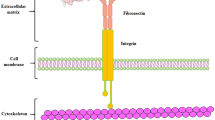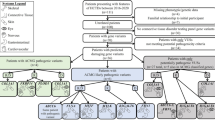Abstract
Deleterious variants in collagen genes are the most common cause of hereditary connective tissue disorders (HCTD). Adaptations of the American College of Medical Genetics and Genomics/Association for Molecular Pathology (ACMG/AMP) criteria are still lacking. A multidisciplinary team was set up for developing specifications of the ACMG/AMP criteria for COL1A1, COL1A2, COL2A1, COL3A1, COL5A1, COL5A2, COL11A1, COL11A2 and COL12A1, associated with various forms of HCTD featuring joint hypermobility, which is becoming one of the most common reasons of referral for molecular testing in this field. Such specifications were validated against 209 variants, and resulted effective for classifying as pathogenic and likely pathogenic null alleles without downgrading of the PVS1 level of strength and recurrent Glycine substitutions. Adaptations of selected criteria reduced uncertainties on private Glycine substitutions, intronic variants predicted to affect the splicing, and null alleles with a downgraded PVS1 level of strength. Segregation and multigene panel sequencing data mitigated uncertainties on non-Glycine substitutions by the attribution of one or more benignity criteria. These specifications may improve the clinical utility of molecular testing in HCTD by reducing the number of variants with neutral/conflicting interpretations. Close interactions between laboratory and clinicians are crucial to estimate the a priori utility of molecular test and to improve medical reports.


Similar content being viewed by others
Data availability
The datasets generated and analyzed during the current study are available from the corresponding author on reasonable request.
References
Akawi NA, Al-Gazali L, Ali BR (2012) Clinical and molecular analysis of UAE fibrochondrogenesis patients expands the phenotype and reveals two COL11A1 homozygous null mutations. Clin Genet 82(2):147–156. https://doi.org/10.1111/j.1399-0004.2011.01734.x
Bekdache GN, Begam MA, Chedid F, Al-Gazali L, Mirghani H (2013) Fibrochondrogenesis: prenatal diagnosis and outcome. J Obstet Gynaecol 33(7):663–668. https://doi.org/10.3109/01443615.2013.817977
Biesecker LG, Harrison SM, ClinGen Sequence Variant Interpretation Working (2018) The ACMG/AMP reputable source criteria for the interpretation of sequence variants. Genet Med 20(12):1687–1688. https://doi.org/10.1038/gim.2018.42
Brnich SE, Abou Tayoun AN, Couch FJ, Cutting GR, Greenblatt MS, Heinen CD, Kanavy DM, Luo X, McNulty SM, Starita LM, Tavtigian SV, Wright MW, Harrison SM, Biesecker LG, Clinical Berg JS, Genome Resource Sequence Variant Interpretation Working (2019) Recommendations for application of the functional evidence PS3/BS3 criterion using the ACMG/AMP sequence variant interpretation framework. Genome Med 12(1):3. https://doi.org/10.1186/s13073-019-0690-2
Chen JM, Masson E, Zou WB, Liao Z, Génin E, Cooper DN, Férec C (2023) Validation of the ACMG/AMP guidelines-based seven-category variant classification system. medRxiv. https://doi.org/10.1101/2023.01.23.23284909
Colman M, Castori M, Micale L, Ritelli Colombi M, Ghali N, Van Dijk F, Marsili L, Weeks A, Vandersteen A, Rideout A, Legrand A, Frank M, Mirault T, Ferraris A, Di Giosaffatte N, Grammatico P, Grunert J, Frank C, Symoens S, Syx D, Malfait F (2022) Atypical variants in COL1A1 and COL3A1 associated with classical and vascular Ehlers-Danlos syndrome overlap phenotypes: expanding the clinical phenotype based on additional case reports. Clin Exp Rheumatol 134(5):46–62. https://doi.org/10.55563/clinexprheumatol/kzkq6y
Ewans LJ, Colley A, Gaston-Massuet C, Gualtieri A, Cowley MJ, McCabe MJ, Anand D, Lachke SA, Scietti L, Forneris F, Zhu Y, Ying K, Walsh C, Kirk EP, Miller D, Giunta C, Sillence D, Dinger M, Buckley M, Roscioli T (2019) Pathogenic variants in PLOD3 result in a Stickler syndrome-like connective tissue disorder with vascular complications. J Med Genet 56(9):629–638. https://doi.org/10.1136/jmedgenet-2019-106019
Ghosh R, Harrison SM, Rehm HL, Plon SE, Biesecker LG, ClinGen, Sequence Variant Interpretation Working (2018) Updated recommendation for the benign stand-alone ACMG/AMP criterion. Hum Mutat 39(11):1525–1530. https://doi.org/10.1002/humu.23642
Heyne HO, Karjalainen J, Karczewski KJ, Lemmelä SM, Zhou W, FinnGen, Havulinna AS, Kurki M, Rehm HL, Palotie A, Daly MJ (2023) Mono- and biallelic variant effects on disease at biobank scale. Nature 613(7944):519–525. https://doi.org/10.1038/s41586-022-05420-7
Kelly MA, Caleshu C, Morales A, Buchan J, Wolf Z, Harrison SM, Cook S, Dillon MW, Garcia J, Haverfield E, Jongbloed JDH, Macaya D, Manrai A, Orland K, Richard G, Spoonamore K, Thomas M, Thomson K, Vincent LM, Walsh R, Watkins H, Whiffin N, Ingles J, van Tintelen JP, Semsarian C, Ware JS, Hershberger R, Funke B (2018) Adaptation and validation of the ACMG/AMP variant classification framework for MYH7-associated inherited cardiomyopathies: recommendations by ClinGen’s Inherited Cardiomyopathy Expert Panel. Genet Med 20(3):351–359. https://doi.org/10.1038/gim.2017.218
Malfait F, Wenstrup R, De Paepe A (2007) Classic Ehlers-Danlos Syndrome. In: Adam MP, Mirzaa GM, Pagon RA, Wallace SE, Bean LJH, Gripp KW, Amemiya A (eds) GeneReviews® [Internet]. Seattle (WA): University of Washington, Seattle. PMID: 20301422
Malfait F, Symoens S, Goemans N, Gyftodimou Y, Holmberg E, Lopez-Gonzalez V, Mortier G, Nampoothiri S, Petersen MB, De Paepe A (2013) Helical mutations in type I collagen that affect the processing of the amino-propeptide result in an Osteogenesis Imperfecta/Ehlers-Danlos Syndrome overlap syndrome. Orphanet J Rare Dis 8:78. https://doi.org/10.1186/1750-1172-8-78
Masson E, Zou WB, Génin E, Cooper DN, Le Gac G, Fichou Y, Pu N, Rebours V, Férec C, Liao Z, Chen JM (2022) Expanding ACMG variant classification guidelines into a general framework. Hum Genomics 16(1):31. https://doi.org/10.1186/s40246-022-00407-x
Micale L, Morlino S, Schirizzi A, Agolini E, Nardella G, Fusco C, Castellana S, Guarnieri V, Villa R, Bedeschi MF, Grammatico P, Novelli A, Castori M (2020) Exon-trapping assay improves clinical interpretation of COL11A1 and COL11A2 intronic variants in stickler syndrome type 2 and otospondylomegaepiphyseal dysplasia. Genes (Basel). https://doi.org/10.3390/genes11121513
Morlino S, Micale L, Ritelli M, Rohrbach M, Zoppi N, Vandersteen A, Mackay S, Agolini E, Cocciadiferro D, Sasaki E, Madeo A, Ferraris A, Reardon W, Di Rocco M, Novelli A, Grammatico P, Malfait F, Mazza T, Hakim A, Giunta C, Colombi M, Castori M (2020) COL1-related overlap disorder: A novel connective tissue disorder incorporating the osteogenesis imperfecta/Ehlers-Danlos syndrome overlap. Clin Genet 97(3):396–406
Oza AM, DiStefano MT, Hemphill SE, Cushman BJ, Grant AR, Siegert RK, Shen J, Chapin A, Boczek NJ, Schimmenti LA, Murry JB, Hasadsri L, Nara K, Kenna M, Booth KT, Azaiez H, Griffith A, Avraham KB, Kremer H, Rehm HL, Amr SS, Abou Tayoun AN, G. ClinGen Hearing Loss Clinical Domain Working (2018) Expert specification of the ACMG/AMP variant interpretation guidelines for genetic hearing loss. Hum Mutat 39(11):1593–1613. https://doi.org/10.1002/humu.23630
Richards S, Aziz N, Bale S, Bick D, Das S, Gastier-Foster J, Grody WW, Hegde M, Lyon E, Spector E, Voelkerding K, Rehm HL, ALQA Committee (2015) Standards and guidelines for the interpretation of sequence variants: a joint consensus recommendation of the American College of Medical Genetics and Genomics and the Association for Molecular Pathology. Genet Med 17(5):405–424. https://doi.org/10.1038/gim.2015.30
Savige J, Storey H, Watson E, Hertz JM, Deltas C, Renieri A, Mari F, Hilbert P, Plevova P, Byers P, Cerkauskaite A, Gregory M, Cerkauskiene R, Ljubanovic DG, Becherucci F, Errichiello C, Massella L, Aiello V, Lennon R, Hopkinson L, Koziell A, Lungu A, Rothe HM, Hoefele J, Zacchia M, Martic TN, Gupta A, van Eerde A, Gear S, Landini S, Palazzo V, Al-Rabadi L, Claes K, Corveleyn A, Van Hoof E, van Geel M, Williams M, Ashton E, Belge H, Ars E, Bierzynska A, Gangemi C, Lipska-Zietkiewicz BS (2021) Consensus statement on standards and guidelines for the molecular diagnostics of Alport syndrome: refining the ACMG criteria. Eur J Hum Genet 29(8):1186–1197. https://doi.org/10.1038/s41431-021-00858-1
Tavtigian SV, Greenblatt MS, Harrison SM, Nussbaum RL, Prabhu SA, Boucher KM, Biesecker LG, G. ClinGen Sequence Variant Interpretation Working (2018) Modeling the ACMG/AMP variant classification guidelines as a Bayesian classification framework. Genet Med 20(9):1054–1060. https://doi.org/10.1038/gim.2017.210
Tavtigian SV, Harrison SM, Boucher KM, Biesecker LG (2020) Fitting a naturally scaled point system to the ACMG/AMP variant classification guidelines. Hum Mutat 41(10):1734–1737. https://doi.org/10.1002/humu.24088
Acknowledgements
The authors thank the family for their kind availability in sharing the findings within the scientific community. M.C. is a member of the European Reference Network for rare and complex diseases ReCONNET and ERN-Skin. A.F. is a member of the European Reference Network for rare and complex diseases ReCONNET.
Funding
This work was supported by the Italian Ministry of Health ‘Ricerca Corrente 2022–2024. M.C. has received research support from the Patients’ Association ‘Con Giacomo contro vascular Ehlers–Danlos syndrome’. This study was supported by "Ministero della Salute"
Author information
Authors and Affiliations
Contributions
MC, MPL, LM and SM contributed to the study conception and design. Material preparation, data collection and interpretation were performed by MC, CF, VG, MPL, LM, GN, and RP. The first draft of the manuscript was written by MC, MPL, and LM and all authors commented on previous versions of the manuscript. All authors read and approved the final manuscript.
Corresponding author
Ethics declarations
Conflict of interest
The authors declare no conflict of interest for this paper.
Consent to participate
All patients provided written informed consent for participation in this study.
Consent to publish
All patients signed a written informed consent for publication of molecular and clinical data.
Ethics approval
This study was conducted in accordance with the 1984 Helsinki declaration and its following modifications and was approved by the local Ethics Committee (protocol no. 13/CE).
Additional information
Publisher's Note
Springer Nature remains neutral with regard to jurisdictional claims in published maps and institutional affiliations.
Supplementary Information
Below is the link to the electronic supplementary material.
Rights and permissions
Springer Nature or its licensor (e.g. a society or other partner) holds exclusive rights to this article under a publishing agreement with the author(s) or other rightsholder(s); author self-archiving of the accepted manuscript version of this article is solely governed by the terms of such publishing agreement and applicable law.
About this article
Cite this article
Leone, M.P., Morlino, S., Nardella, G. et al. Specifications and validation of the ACMG/AMP criteria for clinical interpretation of sequence variants in collagen genes associated with joint hypermobility. Hum Genet 142, 785–808 (2023). https://doi.org/10.1007/s00439-023-02547-z
Received:
Accepted:
Published:
Issue Date:
DOI: https://doi.org/10.1007/s00439-023-02547-z




